Where to see Giant Cuttlefish in South Australia
WHERE TO SEE GIANT CUTTLEFISH IN SOUTH AUSTRALIA

While beauty will always be in the eye of the beholder, you won't find a more spectacular display of marine life than the annual migration of giant cuttlefish near Whyalla on SA’s Eyre Peninsula.
We know that South Australia has some amazing wildlife experiences. From swimming with seals, cosying up to kangaroos or camping with koalas, there’s no shortage of unique things to do with native Australian fauna.
The Eyre Peninsula in SA’s midwest is a hotbed of animal activity. Port Lincoln has a global reputation for the world’s best shark diving experiences (cheers Rodney Fox); you can swim with seals near Coffin Bay (after you’ve shucked your fair share of oysters), and up the road in Streaky Bay is one of the best places anywhere to spot migrating humpback whales. Unknown to many, however, is the rare opportunity to swim with giant cuttlefish in Whyalla!
WHERE TO SEE GIANT CUTTLEFISH IN SOUTH AUSTRALIA

Hangin' for an underwater adventure? Credit: SATC/Carl Charter
TABLE OF CONTENTS
- What is a Giant Cuttlefish?
- Where can I see a Giant Cuttlefish?
- When should I visit?
- What’s the best way to see the Giant Cuttlefish?
- What equipment do I need to swim with Giant Cuttlefish?
- Where should I stay?
Hang on, what is a Giant Cuttlefish?
Belonging to a class of marine molluscs (cephalopoda) that includes the squid, octopus and nautilus (don't worry we had to look it up too), giant cuttlefish are chunky squid-like creatures with well-developed heads, large eyes and mouths with beak-like jaws.
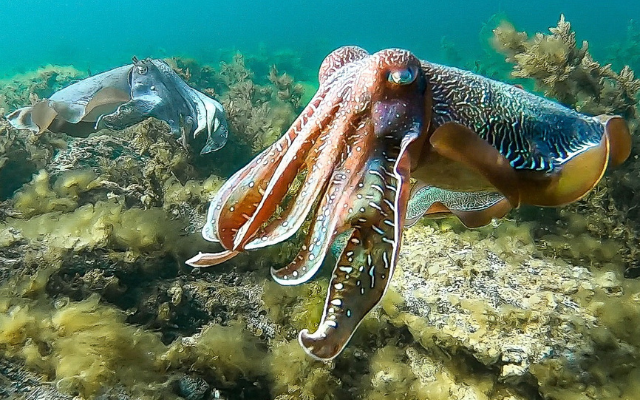
Best caption wins. Credit: SATC/Chris Bell
Surviving off a diet of small crustaceans and smaller fish, giant cuttlefish have a fin that runs around the ‘mantle’ of their body, which can grow up to 50 cm in length, and have eight ‘arms’ with their own suckers plus two tentacles around the mouth. Often reaching around 100 cm in total length, they usually appear blackish-brown with stripes, but this changes dramatically during the breeding season when male cuttlefish put on a show.
As part of the breeding process, the male cuttlefish make it a point to bring out their winter best. Literally shape-shifting to attract and then keep a mate, the colours on display are incredible. With the sheer numbers involved, cuttlefish season is something that every diver, snorkeller or nature enthusiast should see.
5 SURPRISING FACTS ABOUT GIANT CUTTLEFISH

1. Cuttlefish aren’t fish! They are from the family of cephalopods, which is Greek for ‘head-foot.’
2. The colours on display are all part of the annual mating ritual, kind of like an aquatic ‘So You Think You Can Dance?’
3. Cuttlefish are colour-blind! True story. Does make you wonder about the mating ritual described above, right?
4. Giant Cuttlefish can weigh up to 5kg and live up to two years. That's a lot of smaller cuttlefish!
5. Female cuttlefish are polyandrous (look it up), and it takes three to five months for their eggs to hatch.
Where can I see the Giant Cuttlefish?
While giant cuttlefish can be spotted anywhere from the southern coast of Australia to the east and west coasts of Queensland and as far around as Ningaloo Reef in WA, there is something special about the waters inside SA’s Spencer Gulf.
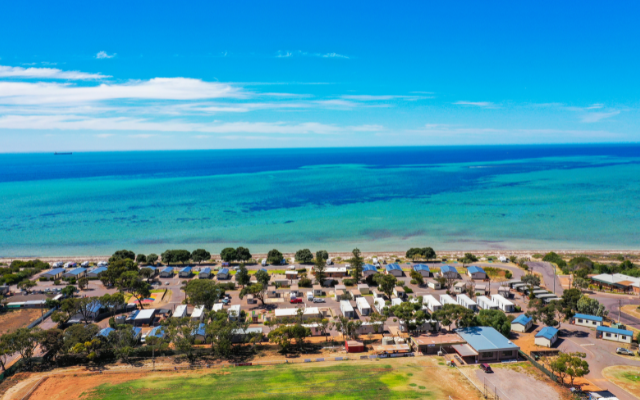
Discovery Parks - Whyalla Foreshore is all about ocean access. What a dream. Credit: John Montesi
Every winter, around 250,000 of these graceful underwater carnivores gather outside Whyalla. The rocky seabeds around Point Lowly, Stony Point and the Upper Spencer Gulf Marine Park provide the perfect environment for the female of the species to lay and delicately attach their eggs.

Does anyone else think Whyalla Jetty looks like the second launch pad in 'Contact?' Credit: SATC
Recognised as the best spot for young families to experience the cuttlefish phenomenon, Stony Point is about 20 km northeast of Whyalla Foreshore. There’s an easily accessible boardwalk that goes into the shallow water that includes a waist-high chain to guide you in and out. There’s also plenty of parking, changing rooms, toilets, and shelter, which means compared to other spots, it’s likely to be the busiest.
At both Stony Point, Fitzgerald Bay and Black Point (not to be confused with the better-known Black Point on Yorke Peninsula), the giant cuttlefish can often be found in only a metre or two of water, usually within 100m of the shore.
NEED ACCOMMODATION IN WHYALLA?

Discovery Parks - Whyalla Foreshore is your ticket to the Giant Cuttlefish breeding season on the Eyre Peninsula. Choose your favourite campsite or cabin metres from the beach and a 20-minute drive away from this magical annual event.
When exactly should I visit?
The annual breeding season for giant cuttlefish begins in May, peaks in June and July and lasts until August when numbers start to thin out. This means that the water is cooler (between 11 and 14 degrees celsius), but once you’re interacting with these incredible creatures, it will be worth it.

This could be you! Credit: SATC/Carl Charter
Mornings are generally the best time to ensure a large population at your chosen vantage point, and this is also when the water is most likely to be calmer, improving visibility.
Thirty years ago the environment around the Upper Spencer Gulf Marine Park was heavily fished and cuttlefish became endangered. This was rectified when the entire region and the cuttlefish itself became protected during the breeding season, ensuring this spectacular annual event lives on.
What’s the best way to see giant cuttlefish?
There are several organised tours available that will explain the environmental significance of the giant cuttlefish and then get you in the water, but for the most part, because there is no cost involved, swimming with the cuttlefish can be a completely independent activity.
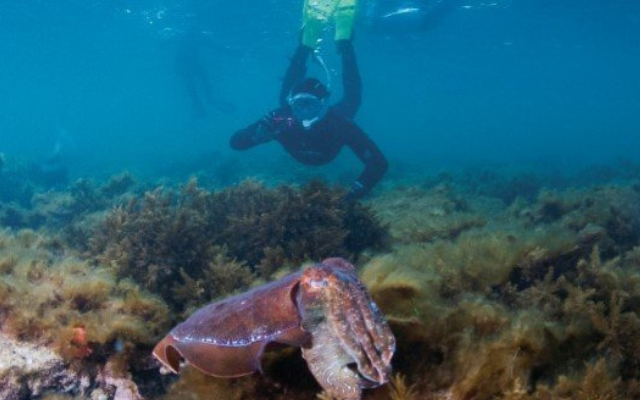
G'day! Credit: Pure SA
Before you arrive, it's worth giving the Whyalla Visitor Centre a call on 1800 088 589 for all the information you need to see the cuttlefish. Divers without their own gear can hire it from Whyalla Diving Services or join a snorkelling group with a buddy or solo.
Snorkelling
Snorkelling is the easiest and most popular way to see the giant Whyalla Cuttlefish. Even though you will remain mostly on the surface, you will need a full-length wetsuit, boots and gloves. If you don’t have your own wetsuit, which is highly recommended, you can hire them from the nearby dive shop.
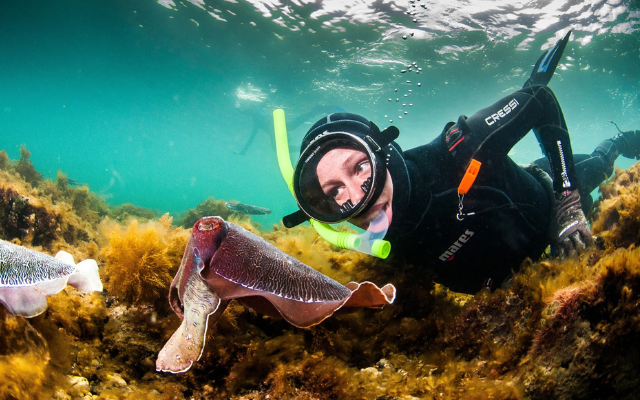
Don't mind me! Credit: SATC/Carl Charter
Remember, there is no charge to swim with the cuttlefish; simply suit up, navigate the rocky entry points and walk into the water. It won’t be long before you’re swimming with these fascinating sea creatures.
Is it safe to swim near cuttlefish?

You know what they're up to. Credit: SATC/Carl Charter
How can we put this politely…the giant cuttlefish are only there for one reason - to mate, lay eggs and breed! Ok, that's three, but so as long as you don’t try to touch them or interfere with this process, you’ll be fine. Rule of thumb: move slowly, keep a respectful distance and don’t disturb mother nature in action!
Diving
Even though Whyalla’s giant cuttlefish live in shallow water, diving is a popular way to view them. While you’ll only be at 4-6 metres of depth, diving is the perfect way to feel part of the cuttlefish’s world.

Is it just me or this Close Encounters of the Third Kind vibes? Credit: SATC/Carl Charter
It’s cold in the water at this time of year (between 11-14 degrees celsius) so divers should anticipate being in the water for less than 60 minutes.
Glass bottom boat
If you prefer the idea of staying dry, you can book a glass-bottom boat tour!
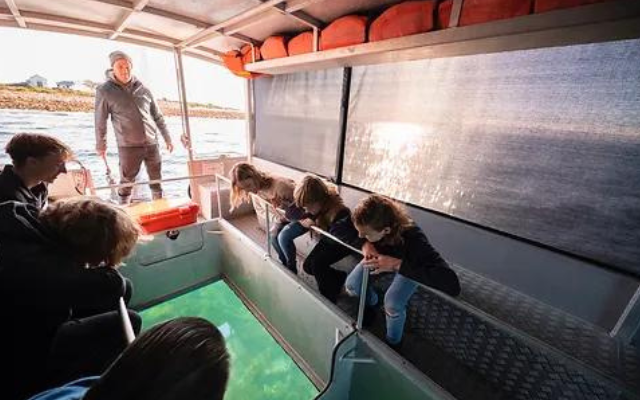
Stay dry! Credit: Cutty's Glass Bottom Boat Tours
Cruise operator Cutty's run a Whyalla Giant Cuttlefish Glass Bottom Boat Tour from May through June and these small group experiences leave from Point Lowly. The cruises run multiple times a day and are a great way to get lots of information about the cuttlefish from an expert guide, keep a roof over your head and see some of Whyalla’s other marine life at the same time!
Cuttlefish Snorkelling & Diving Guided Tours
If you want your Whyalla giant cuttlefish experience to be completely hassle-free, book a cuttlefish package tour with Pure SA. There are snorkelling and diving options, all led by experienced and knowledgeable guides.

You don't need to look up! Credit: Cutty's Glass Bottom Boat Tours
It’s fine to be a bit nervous about going into the water alone, so these tours will buddy you up with another diver and one-on-one guided swims are also available.
What equipment do I need to bring to swim with the cuttlefish?
The most important thing to remember about seeing the giant cuttlefish in Whyalla is the water temperature - it’s cold! Therefore it’s best to come prepared with a neoprene wetsuit (preferably full body), boots that make the rocky entrances easier to navigate, gloves and of course a reliable snorkel. Hoods are also highly recommended and available to hire if you don’t have your own.

I was born this way baby. Credit: Pure SA
Remember, this phenomenon is unique to this part of the world, and will regularly attract international film crews, so these are moments you don’t want to forget. Get your David Attenborough on by remembering to bring a decent underwater camera with you, which doesn’t have to cost the earth!
Plan your trip to see South Australia’s Giant Cuttlefish today!
BOOK ACCOMMODATION AT WHYALLA FORESHORE

Discovery Parks - Whyalla Foreshore is your ticket to the Giant Cuttlefish breeding season on the Eyre Peninsula. Choose your favourite campsite or cabin metres from the beach and a 20-minute drive away from this magical annual event.




